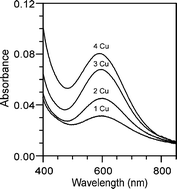Copper(ii) complexes of prion protein PEG11-tetraoctarepeat fragment: spectroscopic and voltammetric studies
Abstract
Spectroscopic (

* Corresponding authors
a
Dipartimento di Scienze Chimiche, Università di Catania, Viale A. Doria 6, Catania, Italy
E-mail:
rbonomo@unict.it
Fax: +39 095 337678
Tel: +39 095 7385093
b Istituto di Biostrutture e Bioimmagini – CNR – Unità Organizzativa di Supporto di Catania, Viale A. Doria 6, Catania, Italy
Spectroscopic (

 Please wait while we load your content...
Something went wrong. Try again?
Please wait while we load your content...
Something went wrong. Try again?
R. P. Bonomo, G. Di Natale, E. Rizzarelli, G. Tabbì and L. I. Vagliasindi, Dalton Trans., 2009, 2637 DOI: 10.1039/B821727K
To request permission to reproduce material from this article, please go to the Copyright Clearance Center request page.
If you are an author contributing to an RSC publication, you do not need to request permission provided correct acknowledgement is given.
If you are the author of this article, you do not need to request permission to reproduce figures and diagrams provided correct acknowledgement is given. If you want to reproduce the whole article in a third-party publication (excluding your thesis/dissertation for which permission is not required) please go to the Copyright Clearance Center request page.
Read more about how to correctly acknowledge RSC content.
 Fetching data from CrossRef.
Fetching data from CrossRef.
This may take some time to load.
Loading related content
